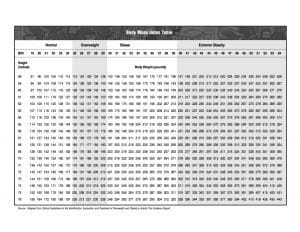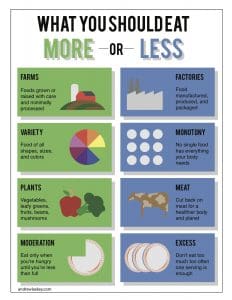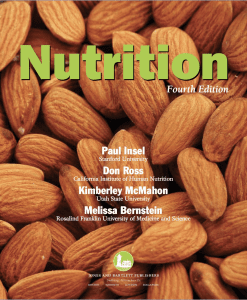“A healthy body weight honors me – and my faith. It’s an established fact that overweight is a significant contributor to disease and premature death. And that’s not the life you were created to live! Treat your body like the sacred vehicle it is by keeping your weight in check. It will honor both you – and your faith.” – Live Healthy In Faith: Faith Community Guide to Promoting Nutrition and Physical Activity.
- Am I at a healthy body weight? Using your Body Mass Index (BMI) is how most health professionals assess a person’s weight to determine if they are underweight, healthy, or overweight. The BMI is a ratio of your height vs. your weight. To find your BMI you can calculate using the formula: (Weight in Pounds / (Height in inches x Height in inches)) x 703. A normal or healthy BMI range is 18.5 – 24.9 according to the CDC. About Adult BMI.
- Or use the chart from the NIH.

- What do I do if I am NOT at a healthy weight? This is a common problem in Georgia and the United States as a whole. The first step to reaching a healthy weight is to determine the amount of calories you need everyday to keep your body functioning normally. To do this we find your Basal Metabolic Rate (BMR). Your BMR is the number of calories your body needs everyday based on your height, weight, age, and gender. To find your BMR use the formulas below. A general rule-of-thumb is that most people can be healthy on a 2,000 calorie/day diet.
- Women: BMR = 655 + (4.35 x weight in pounds) + (4.7 x height in inches) – (4.7 x age in years)
Men: BMR = 66 + (6.23 x weight in pounds) + (12.7 x height in inches) – (6.8 x age in years) - BMR Calculator
- Women: BMR = 655 + (4.35 x weight in pounds) + (4.7 x height in inches) – (4.7 x age in years)
- Calories are the amount of energy in food. Humans get our calories from three main sources, Carbohydrates, Fats, and Protein. When we eat more calories than our body needs we store them as body fat. To get rid of or “burn” that excess body fat we need to use more calories than we eat.
- Carbohydrates and Proteins have FOUR calories per gram, and fats have NINE calories per gram. No one nutrient is better or more important than another. There are lots of fad diets out there that demonize one nutrient or another, however all are important in the co
 rrect balance.
rrect balance.
- Carbohydrates and Proteins have FOUR calories per gram, and fats have NINE calories per gram. No one nutrient is better or more important than another. There are lots of fad diets out there that demonize one nutrient or another, however all are important in the co
This chart shows some fast and easy ways to make healthier food choices. It is also an award winner!
good.is
laweekly.com
- FAT– Fat is very important to have in your diet. Fat aids in many important body processes including nerve function, brain function, and cell structure.
- The USDA recommends that no more than 10% of your daily calories should come from fats*. Say you are following the 2,000 intake, multiply 2,000 by 0.10 = 200 calories from fat. 200 divided by 9 (calories in fat per gram) is 22.2 grams of fat per day.
Some healthy examples of fats are:
Nuts and nut butters – almonds, peanuts, and cashews are some popular ones.
Seeds – sunflower, pumpkin, and flax.
Coconut oil.
Olive oil.
Fats to stay away from:
Saturated animal fats – Whole fat dairy, Fatty red meat.
Deep fat fried foods.
Hydrogenated.
Trans- Fat.
- Protein– Protein is needed for virtually every body process, not just building muscles. Protein is needed to build almost every tissue in your body and for cells to successfully replace themselves.
- The USDA recommends that adults consume about 1-1.8 grams of protein per 2.2 lbs of body weight*. For example a 120lb person- 120 divided by 2.2 = 54.5 grams of protein per day.
Some healthy examples of protein are:
Poultry – chicken and turkey.
Lean beef.
Fish.
Quinoa, and other grains.
Eggs.
Low-fat and fat-free dairy – greek yogurt is very popular, also nut milks.
- Carbohydrates- Carbohydrates break down into sugars in the body. Most fad diets out there love to demonize carbs and sugar, everyone is afraid of carbs. However, carbohydrates are your body’s preferred energy source. Without them your brain function can become quite fuzzy, and eliminating them completely from your diet can put you at risk for kidney disease. Healthy carbohydrates also provide the body with another important nutrient, fiber. An over abundance of carbs and sugars can lead to increased body weight and a risk for Type II diabetes.
- The USDA recommends an average daily intake of 130grams per day of carbohydrates*. That’s 520 calories.
Some healthy examples of carbohydrates are:
Fruit – the sugars in fruit digest faster than grains, but fresh fruit provides many vitamins and health promoting phytochemicals. Phytochemical’s are the special compounds in fruits (and vegetables!) that give them their color and other attributes.
Whole grains – grains that have not been processed or bleached and contain the whole grain kernel. Brown rice, quinoa, and oatmeal are excellent sources.
Starchy vegetables – sweet potatoes, peas, legumes and beans, cauliflower.
Some carbohydrates to stay away from are:
Refined and bleached sugars and flours. White bread and similar products.
“Junk” food – cookies, sweets, most box cereals, soda, most juices. These products contain added sugar.
ADDED SUGAR- Added sugar is in almost everything disguised as many things; High-Fructose Corn Syryp, Agave, Honey, Fructose, Sucrose, Sweetener, Nectar, Dextrose, Corn Syrup Solids, Maltose. Those are just a few examples. Added sugar can add to your risk of Type II Diabetes and should be avoided as much as possible. Added sugar (and fat!) can commonly be found in condiments, canned/ jarred sauces, and dressings. Be careful when adding these to your meals, ask for them on the side and use sparingly.
From the American Diabetes Association: 
Research has shown that drinking sugary drinks is linked to type 2 diabetes.
The American Diabetes Association recommends that people should avoid intake of sugar-sweetened beverages to help prevent diabetes. Sugar-sweetened beverages include beverages like:
regular soda
fruit punch
fruit drinks
energy drinks
sports drinks
sweet tea
other sugary drinks.
These will raise blood glucose and can provide several hundred calories in just one serving!
See for yourself:
Just one 12-ounce can of regular soda has about 150 calories and 40 grams of carbohydrate. This is the same amount of carbohydrate in 10 teaspoons of sugar!
One cup of fruit punch and other sugary fruit drinks have about 100 calories (or more) and 30 grams of carbohydrate.
Read more here.
- Other important foods. Aside from the food and nutrients that provide us with calories for energy there are other foods and nutrients that are very important to promoting health; water, and fiber.
- WATER. Water is the most important nutrient for life. We can go days to weeks with no food, but only a few hours or days without water. When the body is dehydrated it can start to shut down very rapidly. You can overheat, cause organ damage, and brain damage! Always remember to drink AT LEAST 64oz (about 8 glasses) of water everyday. If you’re drinking all that water everyday you wont have time for sugary drinks! As well, making sure your body is fully hydrated can help to flush out the bad things being stored in your tissues.
- FIBER. Fiber is so important in the diet. It can keep you feeling full longer with fewer calories! It is a great weight loss tool. Fiber also helps to keep your heart healthy by removing excess fat from the body, and keeps your large intestine clean. Whole grains get the most attention when it comes to fiber however most vegetables provide excellent fiber.
- Vegetables. Dark-green, leafy vegetables including collard greens, kale, lettuce, broccoli, spinach, chard, cabbage, arugula, and burssel sprouts (just to name a few), are great sources of fiber, keep you feeling full, are VERY low in calories, AND provide those wonderful phytochemicals. All vegetables are excellent for promoting and improving your health, the more colorful the better! The same goes for fruit. Try to “eat a rainbow” everyday.
- Baby steps are key. Should you want to adopt a new, healthy diet it is important to take small steps. If you give up everything you are currently eating and drinking and switch to only the things mentioned here your switch probably won’t last. Slowly switch out some unhealthy foods for healthy ones. Maybe once or twice a week try something new. Always consult your doctor before making large diet changes.
- Weight loss is the same way, take small steps. DO NOT start exercising every waking moment and do hours and hours of cardio. Clean up your diet for a few weeks, drink lots of water, and then start taking small walks around the neighborhood, take the stairs, park farther away in the parking lot, walk and bike when you can. When you feel comfortable consult a professional or your doctor for a structured exercise plan. Sustainable, achievable weight-loss is about one pound per week. Long-lasting weight loss is a marathon, not a sprint. Slow and steady wins this race. If you feel comfortable and want to start some light cardio on your own subtract your age from 220 to find your target heart rate. This is the approximate zone where you will see the most effective fat loss occur. Aim for twenty to thirty mins of aerobic exercise while maintaining your target heart rate, at least three times per week.
*Nutrition; 4th Edition; Insel, Ross, McMahon, Bernstien; 2011.
Medical Disclaimer
Always consult your physician before beginning any exercise or nutrition program. This general information is not intended to diagnose any medical condition or to replace your healthcare professional. Consult with your healthcare professional to design an appropriate exercise or nutrition prescription.


